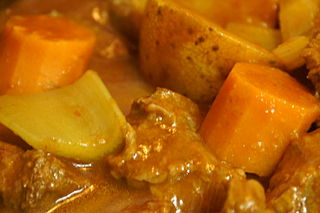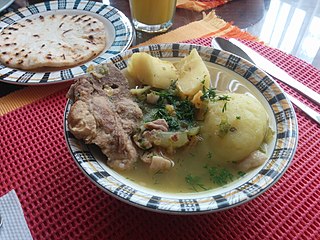
Chowder is a thick soup prepared with milk or cream, a roux, and seafood or vegetables. Oyster crackers or saltines may accompany chowders as a side item, and cracker pieces may be dropped atop the dish. Clam chowder from New England is typically made with chopped clams and diced potatoes, in a mixed cream and milk base, often with a small amount of butter. Other common chowders include seafood chowder, which often consists of fish, clams, and other types of shellfish; lamb or veal chowder made with barley; corn chowder, which uses corn instead of clams; various fish chowders; and potato chowder, which is often made with cheese. Fish, corn, and clam chowders are popular in North America, especially Atlantic Canada and New England.

Tripe is a type of edible lining from the stomachs of various farm animals. Most tripe is from cattle and sheep.

Lancashire hotpot is a stew originating in Lancashire in the North West of England. It consists of lamb or mutton and onion, topped with sliced potatoes and slowly baked in a pot at a low heat.

Finnish cuisine is notable for generally combining traditional country fare and haute cuisine with contemporary continental-style cooking. Fish and meat play a prominent role in traditional Finnish dishes in some parts of the country, while the dishes elsewhere have traditionally included various vegetables and mushrooms. Evacuees from Karelia contributed to foods in other parts of Finland in the aftermath of the Continuation War.

Goulash is a soup or stew of meat and vegetables seasoned with paprika and other spices. Originating in Hungary, goulash is a common meal predominantly eaten in Central Europe but also in other parts of Europe. It is one of the national dishes of Hungary and a symbol of the country.

Irish stew or Stobhach is a stew from Ireland that is traditionally made with root vegetables and lamb or mutton, but also commonly with beef. As in all traditional folk dishes, the exact recipe is not consistent from time to time or place to place. Basic ingredients include lamb, or mutton, as well as potatoes, onions, and parsley. It may sometimes also include carrots. Irish stew is also made with kid. Irish stew is considered a national dish of Ireland.
Irish stew is a celebrated Irish dish, yet its composition is a matter of dispute. Purists maintain that the only acceptable and traditional ingredients are neck mutton chops or kid, potatoes, onions, and water. Others would add such items as carrots, turnips, and pearl barley; but the purists maintain that they spoil the true flavour of the dish. The ingredients are boiled and simmered slowly for up to two hours. Salt can be added before or after the cooking. Mutton was the dominant ingredient because the economic importance of sheep lay in their wool and milk produce, and this ensured that only old or economically non-viable animals ended up in the cooking pot, where they needed hours of slow cooking. Irish stew is the product of a culinary tradition that relied almost exclusively on cooking over an open fire. It seems that Irish stew was recognised as early as about 1800.

Scouse is a type of stew typically made from chunks of meat with potatoes, carrots, and onion. It is particularly associated with the port of Liverpool; hence, the inhabitants of that city are often referred to as "scousers". The word "scouse" comes from lobscouse, a stew commonly eaten by sailors throughout northern Europe in the past, and surviving in different forms there today.

Sancocho is a traditional stew in several Caribbean and Latin American cuisines. Latin variations represent popular national dishes in Dominican Republic, Colombia, Cuba, Honduras, Mexico, Panama, Puerto Rico, Trinidad and Tobago, and Venezuela. It usually consists of large pieces of meat, tubers and vegetables served in a broth.

Pörkölt is a meat stew which originates from Hungary, but is eaten throughout Central Europe.

Ugandan cuisine consists of traditional and modern cooking styles, practices, foods and dishes in Uganda, with English, Arab, and Asian influences.

The cuisine of the Democratic Republic of the Congo varies widely, representing the food of indigenous people. Cassava, fufu, rice, plantain and potatoes are generally the staple foods.

Lobscouse is a thick stew common to multiple Northern European countries made of meat and potatoes.

Pichelsteiner is a German stew that contains several kinds of meat and vegetables.

Cocido lebaniego is a traditional dish from the region of Liébana in Cantabria, Spain. This stew has some essential ingredients, which include chickpea from the municipality of Potes, potatoes, and collard greens. The rest of the elements of this recipe are known as compangu, which refers to meat from the pig slaughter, such as bacon (tocino), black pudding (morcilla), chorizo, and ham. Another additional ingredient is beef, especially cecina, bones and a stuffing made of bread flour, eggs, chorizo, and parsley.

A stew is a combination of solid food ingredients that have been cooked in liquid and served in the resultant gravy. Ingredients can include any combination of vegetables and may include meat, especially tougher meats suitable for slow-cooking, such as beef, pork, venison, rabbit, lamb, poultry, sausages, and seafood. While water can be used as the stew-cooking liquid, stock is also common. A small amount of red wine or other alcohol is sometimes added for flavour. Seasonings and flavourings may also be added. Stews are typically cooked at a relatively low temperature, allowing flavours to mingle.

Arab Indonesian cuisine is characterized by the mixture of Middle Eastern cuisine with local Indonesian-style cuisine. Arab Indonesians brought their legacy of Arab cuisine—originally from Hadhramaut, Hejaz, Sudan and Egypt—and modified some of the dishes with the addition of Indonesian ingredients. The Arabs arrived in the Nusantara archipelago to trade and spread Islam. In Java, since the 18th century AD, most of Arab traders settled on the north coast and diffuse with indigenous, thus affecting the local cuisine culture, especially in the use of goat and mutton meat as well as ghee in cooking.















